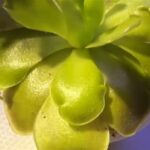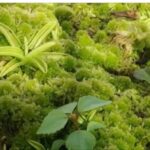As an Amazon Associate, this site earns commissions from qualifying purchases. For more details, click here.
Drosera capensis or Cape Sundews is the most popular drosera variant. It is a beautiful carnivorous plant and also happens to be one of the easiest to grow. If you are interested in caring for drosera capensis, this guide explains everything you need to get started.
Drosera capensis needs 8 hours of full and partial sunlight, with the ideal temperature between 65-100 F. Soil for Cape Sundews must always be moistened and not be fertilized. Only indoor sundews need manual feeding 2-4 times a month.
Drosera Capensis Care Sheet
| Soil | 1:1 peat and perlite, soil must be always moist |
| Water | Distilled, reverse osmosis or rainwater |
| Light | Full or partial light, natural or artificial, 8 hours |
| Food | Insects, fish food, mealworms |
| Temperature | 65-100 F (20-35 C) |
| Humidity | 40-70% |
| Dormancy | Not required |
| Propagation | Leaf cutting, division, seeds |
Light Requirements For Drosera Capensis
Cape sundews need at least 6 hours of light, but 8 to 12 hours is the best. A combination of full and partial light is the optimal option but artificial lighting also helps.
Cape sundews also grow under full light or shade, while other species like D intermedia does not handle shade well.
If your D. capensis is indoors, leave it on a windowsill where it can be exposed to natural light. If the plant will be outdoors, find a sunny location and leave it there. Full direct light is going to help the Cape Sundews grow really fast, but provide some cover if it gets too hot.
D. capensis only needs partial shade even from intense heat. Full shade can damage the plant so avoid that at all costs.
These plants can adapt to intense light if healthy enough. In this case it eliminates the need for shade. This only applies to D. capensis however, as other sundew species need protection from excess heat.
Artificial Lighting
Fluorescent lights can be used if natural light is not an option or limited. The light must be at least 40 watts and must be on for 12-14 hours a day. We suggest Monios-L Grow Light as it has been tested for sundews and other plants.
Keep the light close to the plant, around 12 inches or so. Move the light closer if the sundew is not growing as fast it should.
Majority of Cape sundews can handle harsh lighting be it natural or artificial. You should only reduce its exposure if the dew and/or leaves are drying out. Otherwise just leave the sundew under sunlight so it can grow continuously.
Temperature and Humidity
You can keep Cape Sundews outdoors if the temperature does not fall below 55 F (13 C). The optimum temperature range is 65-100 F (20-35 C).
Some D. capensis can handle temperature above 100 F, but only for short periods. Prolonged exposure could lead to overheating. The sticky stuff (dew) could dry up, making it impossible for sundews to eat. Sunburned sundew leaves turn brown, dry and crispy before falling off. If you see any of these signs, it means the sundew is getting sunburned and needs some shade.
Humidity Level
Drosera capensis prefer 40-70% humidity. Because these plants grow in bogs in the wild, it is no surprise they prefer a sunny, humid environment.
For outdoor D. capensis you can create a garden bog though that takes a bit of time. A simpler solution is to find the sunniest location in your garden. Put the sundew pot in a tray, fill it with an inch or two of water and you are set.
If the plant is indoors you can use a humidifier to keep it at specific levels. The higher the humidity the more dew D. capensis can produce. Humidifiers are not mandatory though. If you live in a tropical climate and the temperature rarely exceeds 100 F, the humidity level should be sufficient.
Soil and Pot
The best soil mix for Drosera capensis is 50% peat moss and 50% perlite. You may also use 50% long sphagnum fiber and 50% silica sand. Keep the soil moist at all times because sundews cannot survive in dry soil.
Never use fertilized soil on Cape Sundews. These carnivorous plants prefer poor soil and planting them in nutritious dirt will be fatal. There are many reasons why sundews die, and using the wrong soil is one of them.
Carnivorous plants get their nutrients from prey, so a nitrogen rich soil is not necessary. Their internal processes are used to obtaining these elements from their traps, not the soil.
If you introduce nutrients into the soil this could kill the plant. This applies not just to D. capensis but all sundews. So when you buy soil for sundews, make sure it is not enriched. Soil Sunrise for instance, is well suited or sundews.
Drosera capensis are usually planted in 4 inch pots. A smaller pot will do nicely if the plant is still young. The benefit of using deep pots is you give the roots space to grow. No matter what the pot size is, make sure there is good drainage for the soil.
How to Water Sundew Soil
Place the Cape Sundew pot in a tray and add 1 to 2 inches of water. An inch of water is fine if you are using a 3 inch pot. Your goal is to keep the soil moist so adjust the water level accordingly.
For a 4 inch pot, pour 2 inches of water. If the soil gets too damp, reduce it to one inch or use a deeper pot. If the soil is too dry, add more water. Sundews love water so 2 inches should be fine though. Refill the tray to prevent the soil from drying out.
Feeding
Drosera capensis may be fed 2 to 4 times monthly. Only indoor sundews should be fed because outdoors the plant catches prey by itself.
Cape Sundews get their prey the same way as all other drosera. The dew or mucilage on their tentacles produce a fruity smell that lures insects, worms and even small frogs.
The mucilage sticks to the insect and traps it. As it tries to break free, the tentacle curls over and tightens its grip. Eventually the bug is pulled deeper into the plant where it is digested.
Caps sundews have special enzymes that allow it to consume these insects. Flies, mosquitoes, aphids, gnats, spiders and other insects are rich in nitrogen, the element these plants need. So what is lacking in the soil sundews get from these creatures.
Insects can smell dew from far away so if your Cape Sundew is outdoors they will come to it. You can tell if a sundew is eating because one of its tentacles is curled over an insect.
It takes 2 to 4 weeks for a Cape Sundew to consume a meal, so do not be surprised if you always see a tentacle closed. If your sundew looks healthy and gets enough sun and water, there is no need for manual feeding on your part.
But if the plant is inside with closed doors and windows, manual feeding is a must. The plant might catch a fly every now and then. But it needs regular feeding to grow and stay healthy. Do not overfeed the plant as it could affect their growth.
Dormancy and Propagation
Cape Sundews do not need dormancy, but some of them may lose their leaves during winter. As long as the temperature does not drop below freezing it should be fine. If you are worried about winter, keep the plant indoors and keep an artificial light on it 14 hours a day.
There are three ways to propagate D. capensis: seeds, leaf cuttings and rhizome division. Seeding is the most effective as its germination rate is high.
Rhizome division involves splitting the plant at the base, so it can be a bit tricky for beginners. You have to dig the plant up and be careful when you cut it off. When you have divided the rhizome, float it in water and leave it there. In time seeds will appear.
Leaf cuttings is exactly what it sounds like. Wait for your Cape Sundew to mature and then cut off some leaves. Sow the leaves and wait for it to grow.
Conclusion
Probably the biggest challenge to growing drosera capensis is setting up an appropriate environment. But the key is in the preparation, so as long as you have the materials ready, raising for this plant should be straightforward.

My fascination with carnivorous plants began many, many years ago with Venus Fly Traps. Now I am more than happy to impart what I know with other enthusiasts and those who are curious about meat eating plants.



